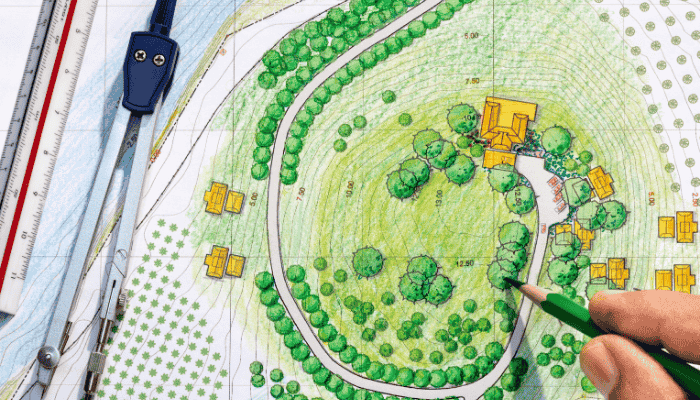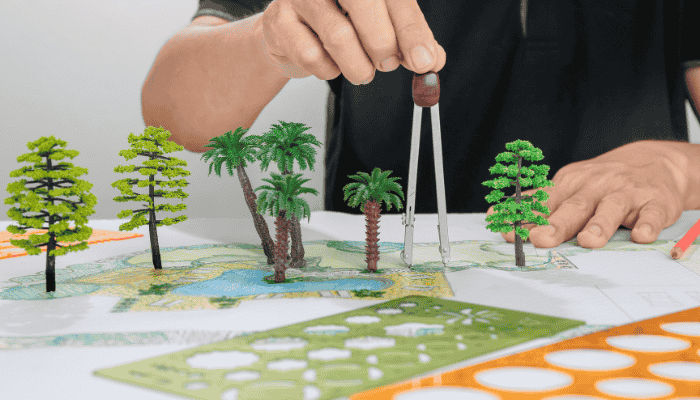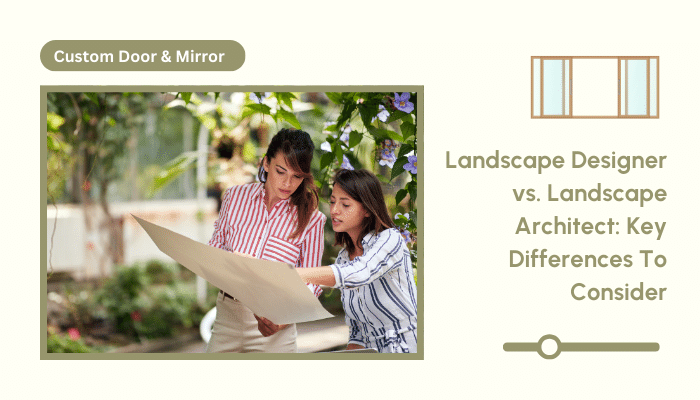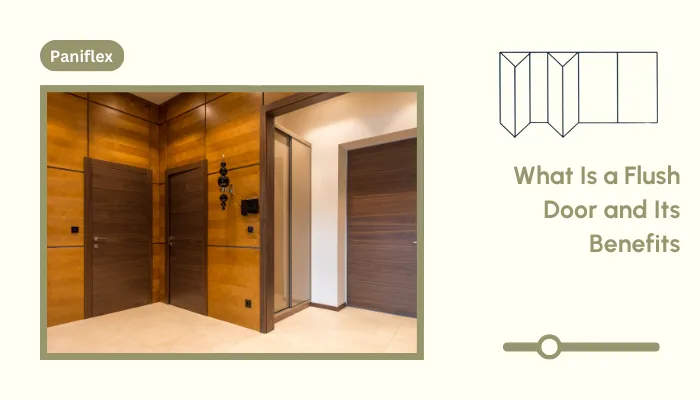Landscape design is crucial in creating functional and visually appealing outdoor spaces. Whether you’re planning a residential garden or a large-scale commercial project, understanding the differences between landscape designers and landscape architects is essential to ensure the success of your endeavor.
Landscape architecture and landscape design are distinct fields that often overlap in their goals but differ in scope, expertise, and approach.
In this article, we’ll delve into the critical distinctions between landscape designers and architects, helping you decide when to hire a professional for your next project.
Landscape Designer vs Landscape Architect: Key Differences

Landscape architects and landscape designers have different skill sets and expertise. Landscape architects typically have a higher level of education and are licensed professionals who handle large-scale, complex projects.
They deeply understand site planning, grading, drainage, and regulatory requirements. Landscape architects often collaborate with other professionals, such as civil engineers and architects, to ensure the seamless integration of the landscape design with the overall project.
On the other hand, landscape designers usually focus on residential and small-scale projects, such as gardens, patios, and outdoor living spaces.
Ready to experience the benefits of custom closet doors? Explore our range of Paniflex products now.
They have a strong knowledge of plants, their growth habits, and how to create aesthetically pleasing compositions. Landscape designers work closely with homeowners to bring their vision to life, focusing on the creative and artistic aspects of the design.
Educational and Professional Requirements

To become a landscape architect, one must earn a bachelor’s or master’s degree in landscape architecture from an accredited institution.
Upon completion of their degree, aspiring landscape architects must pass the Landscape Architect Registration Examination (LARE) to obtain licensure. Additionally, they must participate in continuing education courses to maintain their professional status.
become a landscape designer, typically, a bachelor’s degree in landscape design, landscape architecture, horticulture, or a related field is required. Some professionals enter the field with an associate degree or through extensive hands-on experience.
Certification from organizations like the Association of Professional Landscape Designers (APLD) can enhance credibility, though it isn’t mandatory. Continuing education is also crucial for staying current with industry trends and best practices.
Now that we’ve covered the educational paths, let’s dive into the diverse projects each professional typically handles.
Types of Projects and Expertise Areas

Landscape architects often take on large-scale, commercial projects, such as public parks, corporate campuses, and urban planning. They have the technical expertise to handle complex site challenges, such as grading, drainage, and regulatory compliance. Landscape architects may specialize in sustainable design, green infrastructure, or historic preservation.
Landscape designers typically work on residential projects, focusing on creating beautiful and functional outdoor living spaces. They deeply understand plant selection, garden design, and hardscaping elements like patios and walkways. Some landscape designers may specialize in areas such as native plant gardens, water features, or outdoor kitchens.
Design-build companies offer a comprehensive solution by combining landscape design and installation services. These companies have teams of landscape designers and construction professionals who work together to bring projects from concept to completion, streamlining the process for clients.
Speaking of professionals, let’s explore the pros and cons of choosing a career between landscape designer vs landscape architect.
Decision Factors for Hiring
When organizations decide between hiring a landscape designer vs landscape architect, they consider the following factors:
- Project complexity and scale: A landscape architect’s expertise is invaluable for large-scale, commercial projects with complex site challenges. They have the technical knowledge and experience to navigate regulatory requirements, coordinate with other professionals, and ensure the project’s success.
- Design intricacy: If your project requires intricate 3D modeling and visualization, a landscape architect may be better equipped to handle these aspects. They often use advanced software tools to create detailed plans and renderings, helping clients visualize the final result.
- Budget and timeline: Landscape architects typically command higher fees due to their advanced education, licensure, and the complexity of their projects. If you have a limited budget or a tight timeline, a landscape designer may be a more cost-effective option for residential or small-scale projects.
- Collaboration and project management: For projects that involve multiple stakeholders and require coordination with other professionals, a landscape architect’s project management skills and experience in collaboration can be invaluable. They are trained to work closely with architects, engineers, and contractors to ensure seamless integration and successful project delivery.
After weighing these decision factors, let’s examine the practical aspects of salary and career prospects for both roles.
Ready to experience the benefits of custom closet doors? Explore our range of Paniflex products now.
Salary and Career Prospects
As of 2024, the average annual salary for landscape designers in the United States is approximately $53,000. Salaries typically range from $42,500 to $69,600 per year, depending on factors such as geographic location, experience.
Landscape architects in the United States have an average annual salary of around $75,628, with the potential to earn upto $96,000 depending on experience, location, and project complexity.
Both professions offer opportunities for career growth and advancement. Landscape architects can progress to higher-level positions within firms, such as project managers or principals, or start their practices. They can also pursue specializations and certifications to enhance their expertise and marketability.
Landscape designers can advance their careers by gaining experience, building a solid portfolio, and establishing a reputation for quality work. They may choose to specialize in specific areas of landscape design or start their design firms. Continuing education and professional development opportunities, such as those offered by APLD, can help landscape designers stay current with industry trends and best practices.
The employment outlook for both landscape architects and designers is positive, with the demand for their services expected to grow as the emphasis on sustainable design, green infrastructure, and outdoor living spaces continues to increase.
Want to add a feather to your portfolio?
With all this in mind, let’s wrap things up by summarizing the key takeaways from the differences between landscape designer vs landscape architect.
Conclusion
Understanding the differences between landscape designers and architects is crucial when planning your outdoor project. Landscape architects are best suited for large-scale, complex projects that require technical expertise and coordination with other professionals.
They have advanced education and licensure and a broader scope of work that encompasses site planning, regulatory compliance, and sustainability considerations.
On the other hand, landscape designers are ideal for residential and small-scale projects that focus on creating beautiful and functional outdoor living spaces. They have a strong understanding of plants, garden design, and hardscaping elements and work closely with clients to bring their vision to life.
When choosing between a landscape designer and a landscape architect, consider the complexity and scale of your project, your budget and timeline, and the specific expertise required. By selecting the right professional for your needs, you can ensure that your outdoor space is visually appealing and functional, enhancing your property value and quality of life.
Considering these distinctions will help you make an informed decision and create the outdoor space of your dreams.






